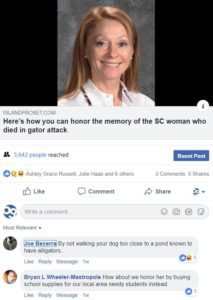I sat on a bench with Wade Livingston the other day. We talked about an alligator attack, a woman who drowned, and the people who saw fit to condemn her for the audacity to up and die while walking her dog.
It’s 968 miles from my house in Missouri to that bench on the South Carolina Coast. It took just 17 words for Livingston to get me there:
Let’s sit on it, here off Governors Lane in Sea Pines on Hilton Head Island, and talk.
And so we did. As did anyone who read Livingston’s story and was moved by it.
Livingston has reported for The Island Packet and its sister edition, The Beaufort Gazette, for the past 2½ years. Senior editor Liz Farrell says he’s the storyteller in the newsroom. This piece – he referred to it in the generic sense as an article, his editor called it a column, and their readers probably didn’t bother to wonder— began with that invitation, and then:
Did you see those Facebook comments folks posted after Cassandra Cline died, just a few feet from this bench?
The question foreshadows a statement. We know what it will be thanks to the headline:
A WOMAN WAS ATTACKED BY AN ALLIGATOR IN SC.
PLEASE STOP ATTACKING HER ON FACEBOOK, SOCIAL MEDIA
Here’s what makes Livingston’s story special. This is not just another screed about the incivility of social media. This story builds its house on questions and treats the trolls respectfully while making clear that their words hurt and aren’t OK.
I liked this story so much I had students in my advanced reporting class at the Missouri School of Journalism read it aloud in a round-robin. Then I made them close their eyes and I read it to them again. Livingston, who earned a master’s degree in journalism to go with a PhD in something completely unrelated, sat in that same classroom just a few years before.
I called Livingston because I wanted to know how he found this story less traveled. It was a few hours after his piece ran online and nine days after he first arrived at Governor’s Lane to help cover the breaking news.
The story from the bench, he says, was born of anger.
Livingston took care with the predictable follow-ups to the news itself: an immediate portrait of the victim and, a few days later, a short piece about memorial services and how to make donations in the wake of a tragic death. Cassandra “Casi” Cline had been a kindergarten teacher, recently transplanted to the South from New York. Requested donations to help students at her old school included glue sticks, backpacks, tissue and No. 2 pencils. That headline:
HERE'S HOW YOU CAN HONOR THE MEMORY
OF THE HILTON HEAD WOMAN
WHO DIED IN A GATOR ATTACK
Through it all came the social media response, much of it sympathetic and some anything but. One scolded that Cline would be alive if she had carried a gun. Another said the alligator shouldn’t be blamed because Cline was the one at fault. And this response, punctuated by a Haha! emoji, to how people could help:
By not walking your dog too close to a pond known to have alligators…
Reading them, Livingston grew livid.

Livingston had come to know a bit about Casi Cline through his reporting. She wasn’t just the victim of a freak accident. She was a wife and a teacher and a friend. She was described in the profile Livingston wrote, the day after her death, as Mary Poppins.
So the morning after he read those comments, Livingston says, he “went off” during the daily newsroom meeting. He railed against assholes who could be so thoughtless and mean. Somewhere in there, he says, he made a pitch, although “really, it wasn’t a pitch — it was a rant with little semblance of structure or clarity.”
His rant hit home. Editors gave him the green light to try … something. That led to a one-on-one discussion with Farrell, his editor. Livingston credits her with distilling his jumbled thoughts. She channeled his anger into brilliant questions directed at the people behind the worst of the online shaming:
- What need did it fulfill for them?
- Would knowing more details change anything?
- Would they say the same thing in person, or just in this civility light, digital bubble?
 Livingston laced those questions throughout his story from the bench. He wrote this specifically about the person who suggested that the best memorial to Cline would be to know better than to walk your dog near “known” alligator haunts:
Livingston laced those questions throughout his story from the bench. He wrote this specifically about the person who suggested that the best memorial to Cline would be to know better than to walk your dog near “known” alligator haunts:I reached out to that guy, sent him a note through Facebook, asked him what, exactly, he intended his comment to mean, and why he posted it – what need did it fulfill?
I love this question. Livingston lets the reader fill in the blanks. The question asks me to think about the nasty post from the point of view of the person who posted it. (The only answer I can come up with, by the way, is that he must be emotionally needy.)
Later in his story, the second question:
Would knowing every detail of the tragedy change people’s response to it — would more information help them better sympathize or empathize with a husband who lost a wife, a family who lost a sister and a daughter, a group of first-graders who lost the teacher who just shepherded them through kindergarten?
He follows with a series of three “we knows” — that people witnessed the attack, that someone called 911, that a neighbor saw Cline’s body dragged out of the water. Then:
We don’t know everything that happened that day, just that something terrible did.
The answer, again, becomes obvious. The post from the shamer is poisoned by his own psychoses, and no detail can change that.
And, almost at the bottom of the story:
Still, I wonder if the folks who used her death as an opportunity to be snarky or funny or cruel would utter the same words here, on this bench.
Would they step from behind their keyboard shields — could they look a person in the eye, and hurt them?
Livingston points his kid-gloved wrath at them. He keeps the rest of us with hiim.

I asked Livingston about framing the story as an invitation and then a series of questions. “The conversation,” he said, “become a gentle reminder that, really, none of us were there when she died, a fact that is at once germane and irrelevant to our conduct but one worth talking about, because physically sitting together and talking — before or in lieu of judging, blaming, etc. — is the point.”
At the heart of that point, Livingston's story implies, is that the people who commented with meanness (they are, after all, more than “commenters,” a word not seen in this story) don’t merit a place on the bench. But by inviting them to sit with him and face his questions, he dares a hope and a challenge:
Maybe they’ll stay quiet the next time…
I hope Livingston never does.



